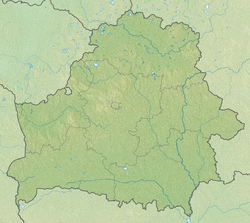Dzyarzhynsk
Dzyarzhynsk
Dzerzhinsk | |
|---|---|
 | |
| Coordinates: 53°41′00″N 27°08′00″E / 53.68333°N 27.13333°E | |
| Country | Belarus |
| Region | Minsk Region |
| District | Dzyarzhynsk District |
| Founded | 1146 |
| Population (2024)[1] | |
• Total | 29,796 |
| Time zone | UTC+3 (MSK) |
| Postal code | 222720 |
| Area code | +375 1716 |
| License plate | 5 |
| Website | Official website |
Dzyarzhynsk or Dzerzhinsk (Belarusian: Дзяржынск, romanized: Dziarzhynsk;[a] Russian: Дзержинск), formerly known as Koydanava until 1932,[b][2] is a town in Minsk Region, Belarus. It serves as the administrative center of Dzyarzhynsk District.[1] As of 2024, it has a population of 29,796.[1]
History
[edit]In the Middle Ages, the village belonged to the Radziwiłłs, a Polish–Lithuanian aristocratic family.
Jewish community
[edit]Jews lived in Koidanova as early as 1620.[3] Koidanova became the site of a new Hasidic Jewish dynasty in 1833 when Rabbi Shlomo Chaim Perlow (1797–1862) became the first Koidanover Rebbe.[4] He was succeeded by his son, Rabbi Boruch Mordechai Perlow (1818–1870), grandson, Rabbi Aharon Perlow (1839–1897), and great-grandson, Rabbi Yosef Perlow of Koidanov-Minsk (1854-1915), who was the last Koidanover Rebbe to live in the town. After World War I, the dynasty was moved to Baranovichi, then in Poland.[5]
In 1847, Koidanova had 2,497 Jewish inhabitants.[3] In 1897, the city had a total population of 4,744, of whom 3,156 were Jews.[6]
Inter-war period
[edit]
In May 1932, it was granted the status of a city and was renamed Koidanau (Belarusian: Ко́йданаў, romanized: Kojdanaŭ) or Koydanov (Russian: Ко́йданов, romanized: Koydanov). In June of that year it was renamed again as Dziaržynsk by the Communist authorities, in honour of Felix Dzerzhinsky (1877–1926), a famous Bolshevik creator and chief of the "Extraordinary Commission" (CHEKA) – the Soviet secret police - who was born in a Dziaržynava estate not far from the city, although on the other side of the then Polish-Soviet border.[3]
The city was the capital of the short-lived Dzierzynszczyzna Polish Autonomous District during 1932–38.[3]
World War II
[edit]It fell under German occupation during World War II. It was captured on 28 June 1941.
The Lithuanian Twelfth Schutzmannschaft (auxiliary police) Battalion's 1st Company, led by Lieutenant Z. Kemzura, massacred approximately 1,600 Jews from the city on 21 October 1941, shooting them and throwing them into a pit; many were buried alive.[7][8][9] As it is reported in The Complete Black Book of Russian Jewry: "For three hours the earth covering the mass grave would move; people still alive were trying to crawl out of their grave."[9] On 1–2 March 1942 the Einsatzgruppen transported several thousand Jews from throughout Belarus and murdered them in Koidanov.[10] The city was liberated by the Soviet Red Army on 6 July 1944.[3]
Modern day
[edit]
In 1998, the city had 24,700 inhabitants.[11]
Now part of Belarus, the name Kojdanava (Belarusian: Койданава) is becoming popular again (it is the official name for the railway station of Dzyarzhynsk), but the official name remains unchanged.[citation needed]
Geography
[edit]The highest point of Belarus, Dzyarzhynskaya Hara, is several kilometers from Dzyarzhynsk.
Transport
[edit]There is a rail route across the city from Minsk Passazhirsky to Baranovichi Polesskie.
There is only one bus route in Dziarzhynsk; there are 18 stops.[citation needed]
Sport
[edit]The local football club is the Arsenal Dzerzhinsk, playing in the Belarusian First League. Its home ground is the City Stadium.
Notable residents
[edit]- Avrom Reyzen (1876–1953), Yiddish writer, poet, and editor
- Joseph Schlossberg (1875–1971), American labor union activist
- Aharon Perlow (1839–1897) – third rebbe of Koidanov
- Karol Hutten-Czapski, Leliwa coat of arms, (1860-1904). Polish Count and philanthropist. President of Minsk, Lithuania (1890-1901)
- Emeryk Hutten-Czapski, Leliwa coat of arms, (1828–1896). Polish Count, scholar, ardent historical collector and numismatist
Notes
[edit]- ^ Official transliteration (2023).
- ^ Also Koidanov; Belarusian: Койданава, romanized: Kojdanava; Russian: Койданов, Койданово, romanized: Koydanov, Koydanovo; Polish: Kojdanów; Yiddish: קוידאַנאָוו, romanized: Koydanov; Lithuanian: Kaidanava.
References
[edit]- ^ a b c "Численность населения на 1 января 2024 г. и среднегодовая численность населения за 2023 год по Республике Беларусь в разрезе областей, районов, городов, поселков городского типа". belsat.gov.by. Archived from the original on 2 April 2024. Retrieved 9 April 2024.
- ^ Экономическая история Беларуси (in Russian). Экоперспектива. 2001. p. 392. ISBN 978-985-6598-81-7.
- ^ a b c d e "Koidanova". Beljews.info. Retrieved August 20, 2011.
- ^ Glassman, Deborah G. (2004). "Rabbonim, Rebbes, and Crown Rabbis, of Lyakhovichi". JewishGen. Archived from the original on February 22, 2015. Retrieved June 20, 2012.
- ^ Nadler, Allen (2010). "Koidanov Hasidic Dynasty". The YIVO Encyclopedia of Jews in Eastern Europe. Retrieved June 20, 2012.
- ^ "Jewish population of Minsk uezd according to the 1897 Russian Census". beljews.info. Retrieved June 20, 2012.
- ^ "Jewish Heritage Research Group in Belarus". Jhrgbelarus.org. October 21, 1941. Archived from the original on December 25, 2017. Retrieved August 20, 2011.
- ^ Breitman, Richard (1997). "Himmler's Police Auxiliaries in the Occupied Soviet Territories". Simon Wiesenthal Center Multimedia Learning Center. Archived from the original on July 27, 2011. Retrieved August 20, 2011.
- ^ a b Patterson, David (June 13, 2003). The Complete Black Book of Russian Jewry. ISBN 9781412820073. Retrieved August 20, 2011.
- ^ United States Holocaust Memorial Museum (1995). Historical Atlas of the Holocaust. Macmillan / Simon & Schuster. ISBN 978-0028974514. See in Routes to Roots Foundation, Inc. Archived August 21, 2016, at the Wayback Machine
- ^ "BELARUS: urban population". Populstat.info. Archived from the original on October 21, 2007. Retrieved August 20, 2011.
External links
[edit] Media related to Dzyarzhynsk at Wikimedia Commons
Media related to Dzyarzhynsk at Wikimedia Commons- Dzerzhinsk (in Russian)
- Photos on Radzima.org
- Map of Dziaržynsk




